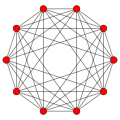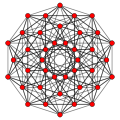This article has multiple issues. Please help improve it or discuss these issues on the talk page . (Learn how and when to remove these messages)
|

A five-dimensional (5D) space is a mathematical or physical concept referring to a space that has five independent dimensions. In physics and geometry, such a space extends the familiar three spatial dimensions plus time (4D spacetime) by introducing an additional degree of freedom, which is often used to model advanced theories such as higher-dimensional gravity, extra spatial directions, or connections between different points in spacetime.







